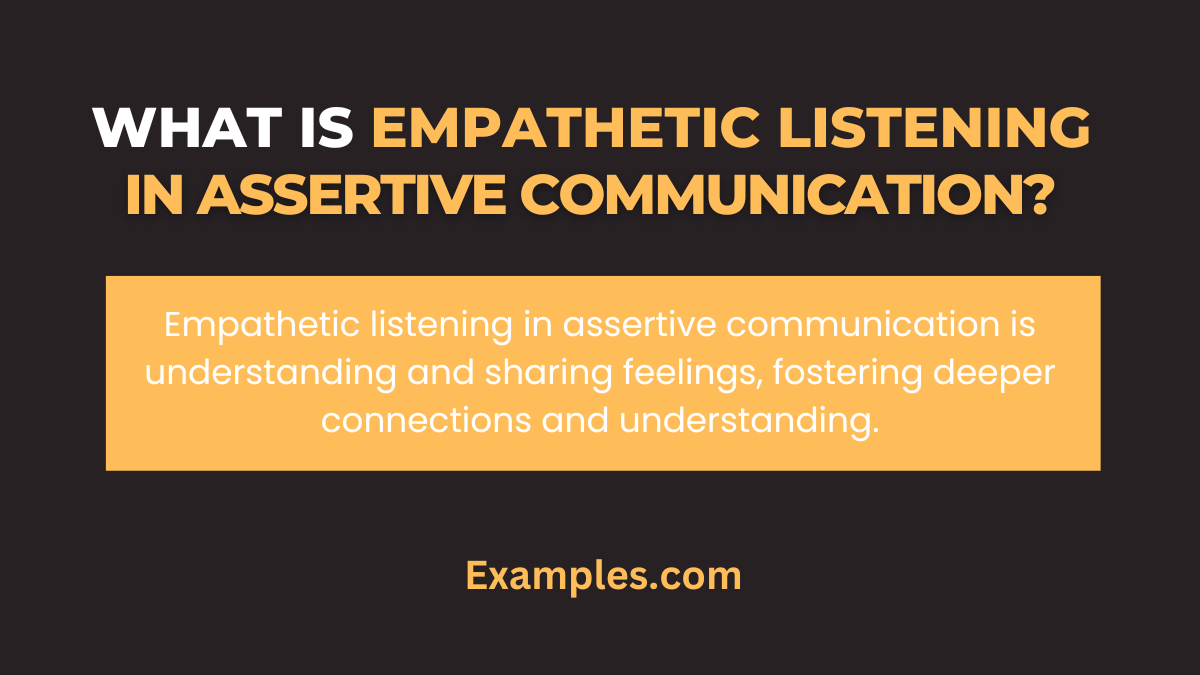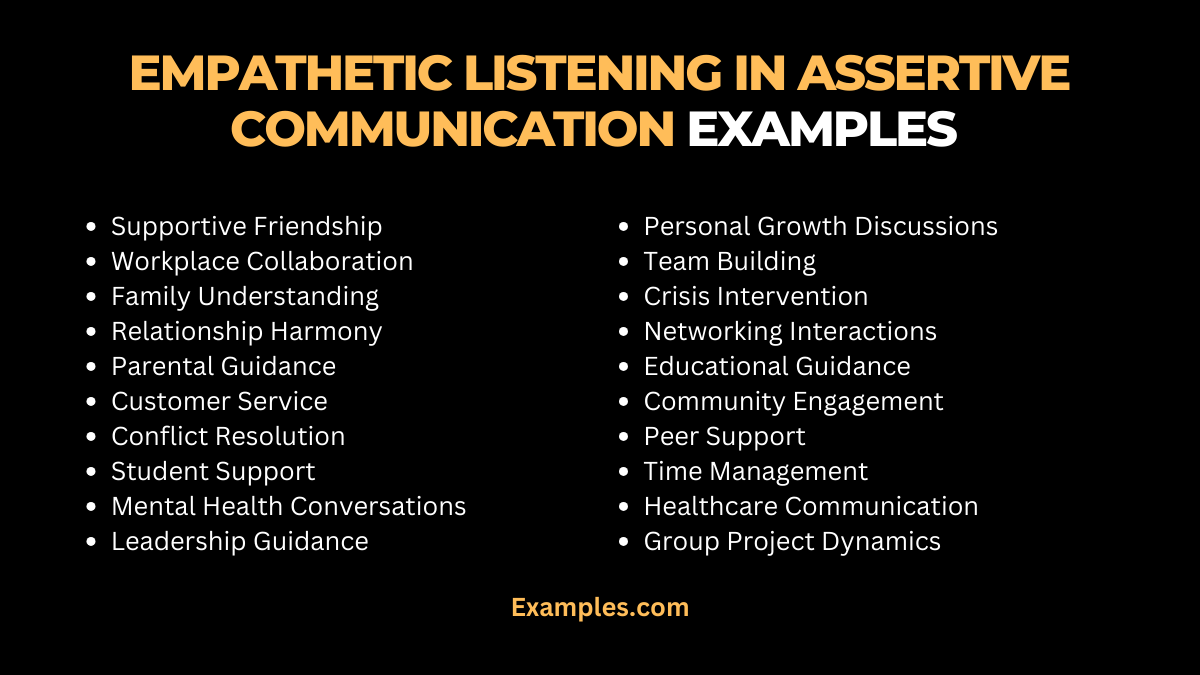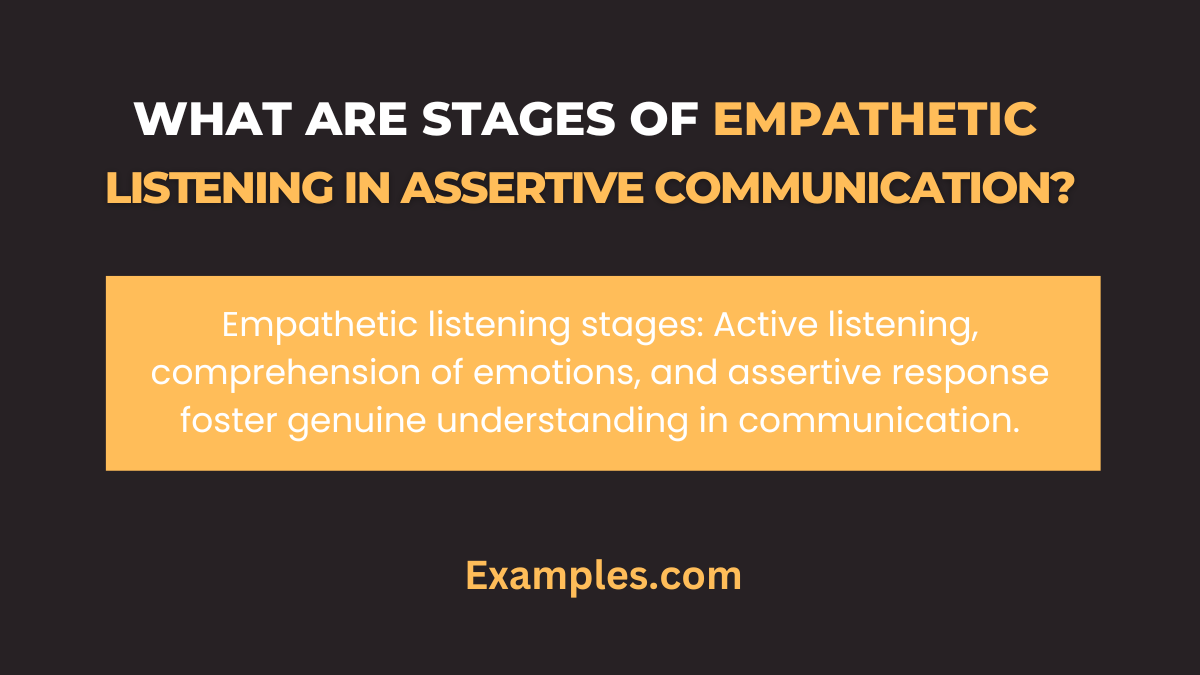19+ Empathetic Listening In Assertive Communication Examples
Unlock the power of empathetic listening in assertive communication with our comprehensive guide. Explore real-world communication examples that showcase the transformative impact of empathetic listening, providing valuable insights and practical tips to elevate your interpersonal connections.
What is Empathetic Listening In Assertive Communication?

In simple terms, empathetic listening in assertive communication involves not just hearing words but understanding and sharing emotions. It goes beyond the surface, fostering genuine connections. This vital skill enhances your interpersonal communication, creating a more collaborative and empathetic environment.
20 Empathetic Listening In Assertive Communication Examples

Explore our collection of 20 empathetic listening examples in assertive communication. Elevate your understanding with these real-life scenarios, each accompanied by a brief explanation. Master the art of connecting through active listening, fostering empathy in your interpersonal interactions.
- Supportive Friendship: In times of distress, being a bold listener and saying, “I’m here for you; let’s face it together” strengthens bonds.
- Workplace Collaboration: Empower teamwork by actively listening to colleagues; respond with assertive encouragement for a motivated work environment.
- Family Understanding: When a family member expresses concerns, practice empathetic listening by saying, “I hear your worries; let’s discuss how we can address them together.”
- Relationship Harmony: In disagreements, practice assertive communication by understanding your partner’s perspective, saying, “I see where you’re coming from; let’s find common ground.”
- Parental Guidance: When a child expresses fears, demonstrate empathetic listening by assuring, “I understand your worries; let’s explore solutions together.”
- Customer Service: Resolve issues effectively by empathetically listening to customer concerns; respond assertively, saying, “I acknowledge your frustration; let’s work towards a solution.”
- Conflict Resolution: In disputes, practice empathetic listening by acknowledging both sides, saying, “I hear your concerns and theirs; let’s find a compromise.”
- Student Support: Empower students by actively listening to their challenges; respond assertively, saying, “I understand your struggles; let’s work towards academic success together.”
- Mental Health Conversations: Show empathy by actively listening to someone going through a tough time; respond with care, saying, “I’m here for you; let’s navigate this journey together.”
- Leadership Guidance: As a leader, practice empathetic listening to employee concerns; respond assertively, saying, “I value your input; let’s find solutions that benefit everyone.”
- Personal Growth Discussions: When a friend seeks advice, practice assertive communication by understanding their goals, saying, “I see your aspirations; let’s explore ways to achieve them.”
- Team Building: Foster team unity by empathetically listening to each member; respond assertively, saying, “I appreciate your perspectives; let’s collaborate for success.”
- Crisis Intervention: During challenging times, practice empathetic listening to those affected; respond assertively, saying, “I hear your distress; let’s work towards recovery together.”
- Networking Interactions: Build professional relationships by actively listening to colleagues; respond assertively, saying, “I value your insights; let’s explore potential collaborations.”
- Educational Guidance: As an educator, practice empathetic listening to student concerns; respond assertively, saying, “I understand your challenges; let’s find ways to enhance your learning experience.”
- Community Engagement: In community discussions, practice empathetic listening to diverse perspectives; respond assertively, saying, “I appreciate your viewpoints; let’s work towards inclusive solutions.”
- Peer Support: Support friends by actively listening to their achievements; respond assertively, saying, “I acknowledge your accomplishments; let’s celebrate together.”
- Time Management: In busy work environments, practice empathetic listening to colleagues overwhelmed with tasks; respond assertively, saying, “I recognize your workload; let’s strategize for efficiency.”
- Healthcare Communication: Show empathy to patients by actively listening to their concerns; respond assertively, saying, “I understand your health worries; let’s develop a holistic care plan.”
- Group Project Dynamics: Foster collaboration in group projects by empathetically listening to each member; respond assertively, saying, “I value your contributions; let’s create an impactful project.”
Empathetic Listening In Assertive Communication Examples for Students
Empower students with assertive communication through empathetic listening. This guide offers real-world examples and practical insights to enhance students’ interpersonal skills, fostering a positive and collaborative learning environment.
- Classroom Challenges: “I see difficulties; let’s plan for improvement together.”
- Peer Conflict Resolution: “Understand both perspectives; find a resolution benefiting everyone.”
- Teacher-Student Discussions: “Acknowledge feelings; let’s address this issue together.”
- Extracurricular Support: “Appreciate contributions; let’s make activities more engaging.”
- Study Group Dynamics: “Value insights; enhance our study approach together.”
- College Transition: “Hear concerns; explore resources for a smoother transition.”
- Bullying Intervention: “Understand experiences; create a safe environment together.”
- Career Guidance: “Appreciate goals; explore pathways to desired professions.”
- Online Learning Support: “Hear struggles; adapt our approach for better learning.”
- Leadership Development: “Value leadership potential; provide growth opportunities.”
What are Stages of Empathetic Listening In Assertive Communication?

In assertive communication, empathetic listening unfolds in three stages. Firstly, it involves active listening, where the focus is on the speaker. Next, comprehension delves into understanding emotions, followed by response, where one articulates understanding and seeks resolution. This process fosters genuine understanding and connection.
What are the Skills of Empathetic Listening In Assertive Communication?
Empathetic listening in assertive communication demands honing several skills. These include active engagement, nonverbal cues interpretation, emotional intelligence, and the ability to withhold judgment. The skill set facilitates a deeper comprehension of the speaker’s perspective, leading to more meaningful and respectful interactions.
Tips for Effective Empathetic Listening In Assertive Communications
- Set the Right Environment: Create a conducive setting for open dialogue.
- Practice Active Engagement: Show genuine interest through verbal and nonverbal cues.
- Validate Emotions: Acknowledge the speaker’s feelings to build trust.
- Withhold Judgment: Suspend personal judgments to truly understand the speaker’s viewpoint.
- Seek Clarification: Ask questions for a comprehensive grasp of the speaker’s message.
Empathetic listening in assertive communication is more than a skill; it’s a pathway to building stronger, more meaningful relationships in both personal and professional spheres. By truly engaging with others’ emotions and perspectives, we pave the way for more effective and respectful communication. This approach not only enhances individual interactions but also contributes to a more empathetic and understanding society. The ability to listen empathetically in assertive communication scenarios is invaluable, providing a foundation for resolving conflicts, building trust, and fostering a collaborative spirit in various settings.
To delve deeper into the nuances of empathetic listening and its role in assertive communication, readers may find valuable insights from educational institutions renowned for their research in psychology and communication. For instance, the Stanford Encyclopedia of Philosophy offers comprehensive articles on empathy, including its psychological and ethical dimensions.
Additionally, the Massachusetts Institute of Technology (MIT) provides extensive resources and research findings on communication strategies and their impact in organizational and interpersonal contexts. These resources can broaden your understanding and application of these critical communication skills.



